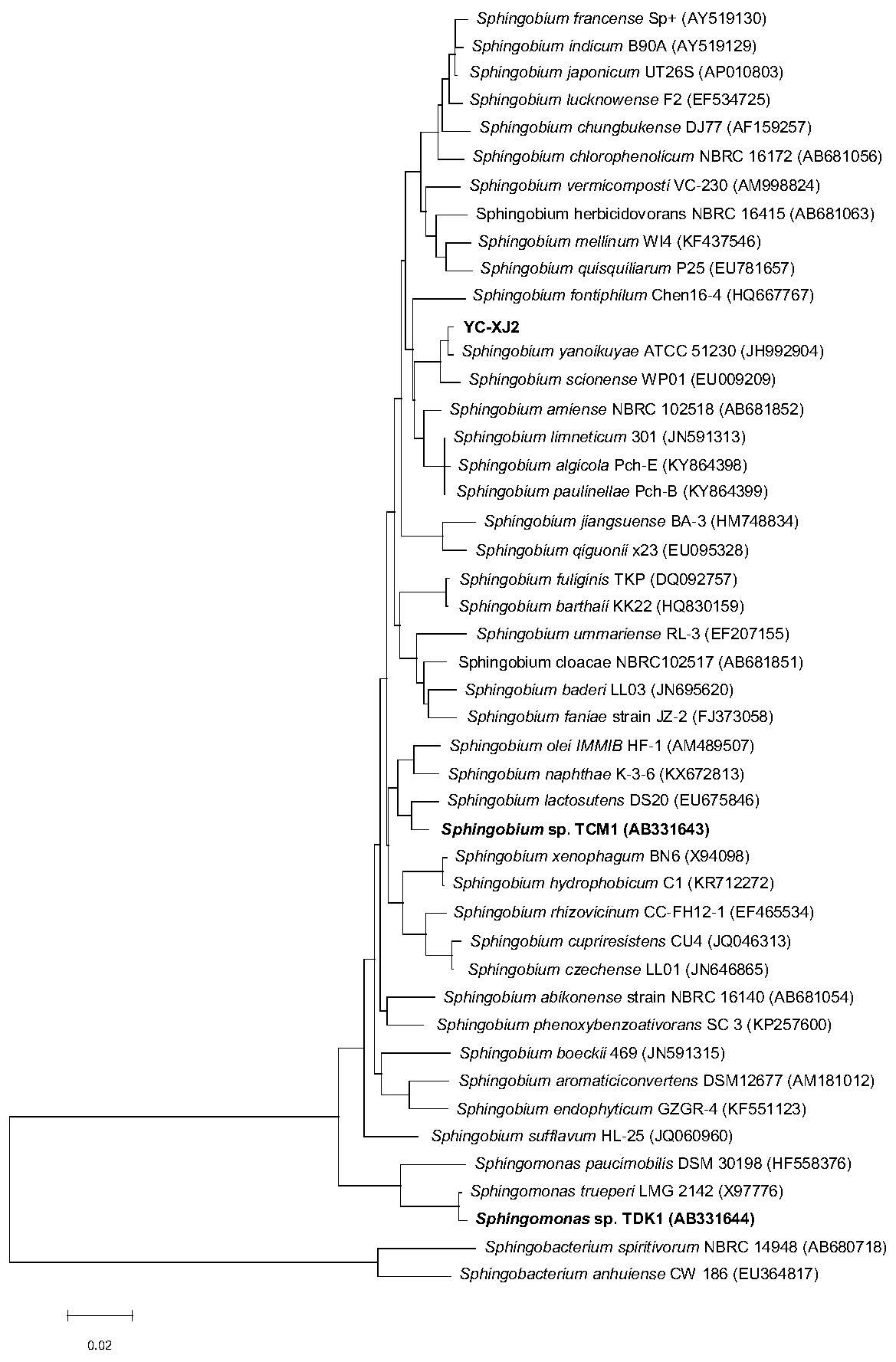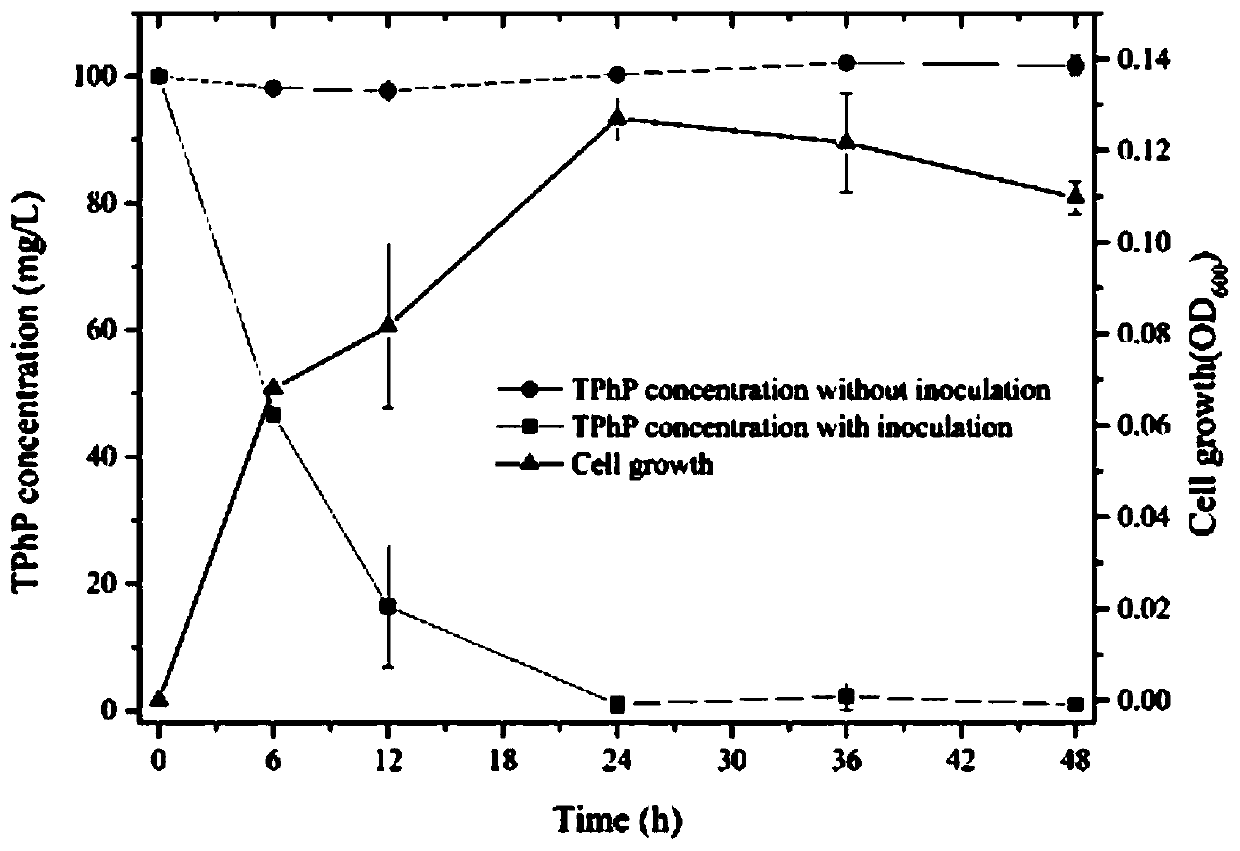Sphingobium yanoikuyae with function of degrading triphenyl phosphate
A technology of ammonia-alcoholic bacteria and bacterial agents, which is applied in the field of microorganisms and biodegradation, can solve the problems of few researches on biodegradation and soil remediation, and achieve the effects of rapid degradation, good economic value and application prospects, and strong salt tolerance
- Summary
- Abstract
- Description
- Claims
- Application Information
AI Technical Summary
Problems solved by technology
Method used
Image
Examples
Embodiment 1
[0029] Example 1 Isolation and Identification of Sphingobacterium sphingosinorrhea YC-XJ2
[0030] Soil samples were collected from the soil in the electronic waste pollution area and inoculated into 100mL inorganic salt ion medium containing 50mg / L TPhP, and cultured at 30°C and 180rpm. Every culture 7 days, get 10% of culture medium volume and inoculate in the fresh inorganic salt ion medium, and the concentration of TPhP is increased by 50mg / L each time, transfer continuously 5 times, in the inorganic salt medium, the TPhP concentration improves to 300mg / L.
[0031] Streak the acclimatized bacteria solution onto an inorganic salt medium plate containing 100mg / L TPhP, and culture it statically at 30°C for 4 days. Pick a single colony on the plate for streaking and culture, and repeat until a purified strain is isolated. The strain with good growth, stable passage and good degradation ability was preserved and named as YC-XJ2.
[0032] 1. Morphological characteristics of t...
Embodiment 2
[0039] Example 2 Degradation performance test of Sphingosinosinum serovar YC-XJ2
[0040] 1. Degradation of triphenyl phosphate by strain YC-XJ2
[0041] Inoculate strain YC-XJ2 into liquid LB medium for activation, and cultivate to logarithmic growth phase OD 600 =0.7, according to the inoculum size of 1% by volume, inoculate in the inorganic salt medium containing each 100mg / L mixture of triphenyl phosphate, and use the inorganic salt medium of 100mg / L triphenyl phosphate of the uninoculated strain as a control group , the control group and the treatment group each set up three replicates. The control group and the treatment group were cultured at 30° C., shaken at 180 rpm and protected from light, and samples were taken every 12 hours to detect the concentration of triphenyl phosphate.
[0042] Add an equal volume of acetonitrile to the triphenyl phosphate degradation sample, oscillate up and down to mix well, take 1 mL of TPhP degradation sample, and then filter it with ...
Embodiment 3
[0057] Application of embodiment 3 sphingosine bacteria YC-XJ2 in soil remediation
[0058] The soil used in this study was taken from the garden soil of the Chinese Academy of Agricultural Sciences. After the soil was removed with a 40-mesh sieve to remove large pieces of hard soil and sand, 10 g was weighed and placed in a 50 mL centrifuge tube, and the following two treatments were first performed: sterilization (121 ° C, 30 min) and non-sterilization.
[0059] Then the specific experimental procedure was carried out according to Table 1, YC-XJ2 bacterial solution was connected, and TPhP was added. For each sample, ensure that the sum of the volume of the added TPhP mother solution and the volume of the inorganic salt medium is 5 mL. Vortex to mix. The samples were placed in an outdoor natural environment for cultivation, during which they were shaken and mixed every 6 hours. After 2 days of cultivation, 10 g of soil samples were extracted to determine the concentration ...
PUM
 Login to View More
Login to View More Abstract
Description
Claims
Application Information
 Login to View More
Login to View More - R&D
- Intellectual Property
- Life Sciences
- Materials
- Tech Scout
- Unparalleled Data Quality
- Higher Quality Content
- 60% Fewer Hallucinations
Browse by: Latest US Patents, China's latest patents, Technical Efficacy Thesaurus, Application Domain, Technology Topic, Popular Technical Reports.
© 2025 PatSnap. All rights reserved.Legal|Privacy policy|Modern Slavery Act Transparency Statement|Sitemap|About US| Contact US: help@patsnap.com



